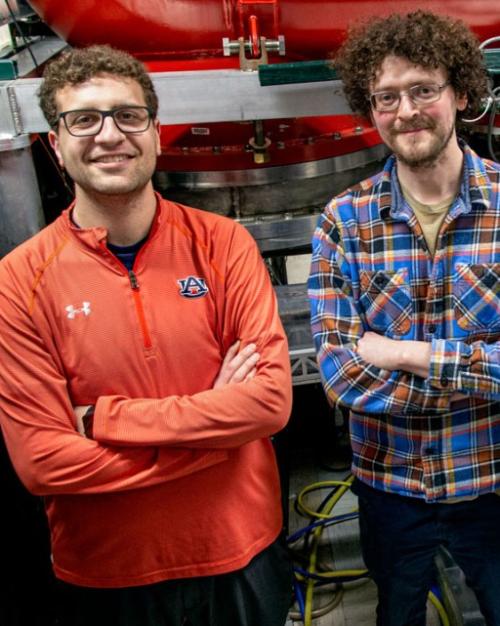Cornell is breaking new ground in electron beam research with the HERACLES beamline, a state-of-the-art electron gun that mimics the harsh environments of the world’s largest particle colliders. Originally designed during the university's Energy Recovery Linac program, the electron gun at the heart of HERACLES has set records for photoinjector current, allowing researchers to study cathodes that can be used in everything from semiconductor manufacturing to the future electron-ion collider.
Accelerator technology relies on photocathodes to produce high-current electron beams for a variety of applications. For example, a robust photocathode can sustain a high current electron beam in particle colliders, where one of the most important criteria is beam luminosity, or number of particle collisions produced. A higher beam current yields a larger luminosity, increasing the rate of new physics discoveries. In machines that do not use electron collisions, a high current electron beam can still improve luminosity by enabling particle beam cooling.
However, the efficiency of the photocathode is sensitive to the vacuum environment inside the accelerator, and can degrade rapidly at high current.
“The inside of an electron gun is a harsh environment,” says Matt Andorf, research associate in the Cornell Laboratory for Accelerator-based Sciences and Education, CLASSE. “So, our photocathodes do not necessarily fail, it’s that we ask a lot of them under extreme conditions.”
Similar to those at large colliders, the HERACLES beamline is constantly maintained in ultra high vacuum. Despite this, remaining residual gas can chemically react with the cathode, degrading its efficiency and damaging the material. The result is known as chemical poisoning. What’s even more problematic, says Andorf, is an effect called ion-back bombardment, where the electron beam itself leads to the ionization of gas molecules inside the electron gun. This effect causes the positively charged ions to accelerate towards the cathode causing further damage.
Researchers at Cornell study these photocathodes by recreating the harsh, yet real-world, environments within HERACLES, while trying to minimize the effects of chemical poisoning and ion-back bombardment.
Leading this charge are CLASSE Researchers and graduate students who have built HERACLES in Newman Laboratory to improve the strength of photocathodes developed for high current beam operation. The commissioning results of HERACLES are presented in a recent publication.
“Now that photocathodes are getting better, we can use them in these very brutal industrial environments.” says Jared Maxson, Assistant Professor of physics in the College of Arts and Sciences. Maxson, along with Professor Ivan Bazarov, is leading this effort.
One such environment, explains Maxson, is the proposed electron-ion collider to be built at Brookhaven National Lab. This large collider will search for quarks and gluons, the particles that form the protons and neutrons in visible matter. To generate these sub-atomic particles, researchers need high-average current electron beams, like those produced in HERACLES.
“We are going to be testing the electron sources for the world’s largest colliders,” says Jared Maxson, For nuclear physics, like the electron-ion collider. Or for high-energy physics, like making a “Higgs factory” for example, whose primary job is to produce lots of Higgs bosons for precision studies of the particle.”
“We are testing the electron sources that are going into these machines, in exactly the same conditions in which they will be used. We are reproducing the sources for these two big accelerators right in our basement of Newman Lab.”
To test these feats of strength HERACLES is equipped with two vacuum chambers, one for cathode storage and another for mapping the cathodes' quantum efficiency (QE). The QE mapping chamber allows researchers to analyze the spatial distribution of the cathode's efficiency, revealing information about its degradation.
HERACLES is big and powerful. Stronger than most DC electron guns at national labs, let alone a university campus where students participate in the design and data collection. The beamline can generate high currents of up to 10 mA, allowing researchers to punish their cathodes with extreme trials that can inform research and industrial applications.
The beamline is also equipped with several diagnostic tools, including viewscreens, a Faraday cup, and a quadrant detector, which provide important information about the beam's position and current.
While HERACLES is primarily used for fundamental research, the knowledge gained from these experiments has the potential to impact a range of real-world applications. For example, electron accelerators are used in medical facilities to generate X-rays for imaging and radiotherapy. Improving the lifespan of cathodes could lead to more reliable and cost-effective accelerators, which could improve patient outcomes. Electron beams can also be used in semiconductor manufacturing, where the CHIPS act has spurred additional investment and energy into this sector.
Researchers will use HERACLES to advance high-current photocathodes by rapidly testing their performance from growth chamber to high-current demonstration. This research is expected to lead to reliable advances in robust, high-current cathode technology.
However, the greatest strength of HERACLES, says Maxson, is not necessarily its power, but the involvement of students in every step of the way. “Students get to operate this thing,” says Maxson. “Graduate students are the ones to put the beam down the pipe and collect the data. Students truly are the scientific drivers of HERACLES.”
Currently, Sam Levenson, a fourth-year grad student funded by The Center for Bright Beams, is one of these drivers. Levenson, prepares, grows, and tests the photocathodes for HERACLES. “Science-wise, it is really impactful to test the cathodes in the same environment as these large colliders,” says Levenson. “We learn a lot about cathode robustness this way, without the constraints associated with larger facilities."
Levenson says that the bulk of his work is now building a new cathode-growth chamber that will attach directly to HERACLES. This will allow researchers to bypass the timely process of transporting the photocathodes to HERACLES from a separate growth chamber. “Saving time is very important and not just because it increases our testing output,” says Levenson. “By getting the cathode into the electron gun sooner, you can more accurately quantify the cathode’s performance at high current.
This work was supported by the Department of Energy under Grant Numbers DESC0021425, DESC0021002, DESC0023517 and the National Science Foundation under Grant No. PHY-1549132, the Center for Bright Beams.






